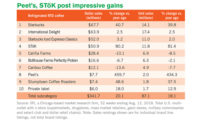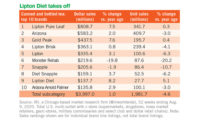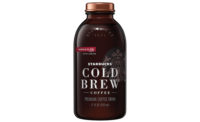Trends in ready-to-drink tea
Increasingly, Americans are slaking their thirst with tea, not bottled water or soft drinks.

Tea and ready-to-drink (RTD) tea achieved estimated sales of $6.7 billion in 2012, according to Chicago-based market research firm Mintel. And sales are expected to grow to nearly $8 billion by 2014, said Douglas Rash, group vice president of global sales for Treatt, Lakeland, Fla., citing statistics from Rockville, Md.-based Packaged Facts.
“As more and more consumers learn the health benefits of various teas, more tea drinkers are constantly coming on board, raising the consumption rate per capita to new heights every year,” said John Wilson, marketing manager for Allen Flavors Inc., Edison, N.J.
“RTD teas have followed the same trend from the beginning. This is largely due to convenience, but there are recent trends indicating that functional teas, which include vitamins, additional epigallocatechin gallate (EGCG), grape seed extracts, antioxidants and, of course, the comfort of non-tea flavors such as peach, raspberry or superfruits, [are] pushing the consumption rate up as well,” Wilson said.
The consumption of iced tea is increasing rapidly in the United States, and growth is projected to increase steadily for the next five years, said John Harper Crandall, vice president of sales for Amelia Bay, John’s Creek, Ga., citing market research and internal sales data.
“This growth is due to a shift in consumer preferences away from soft drinks and bottled water to beverages that are perceived as healthy and functional,” Crandall explains. “Consumers want more from their beverages than just hydration or calories. They want great, satisfying, functional beverages that offer more than just refreshment. Tea is perceived in the industry as a healthy alternative.”
More than 5,600 scientific studies on the health benefits of tea have been conducted recently, as was reported at the 2012 U.S. Department of Agriculture’s fifth annual conference.
“These studies link tea with cardiovascular health, cognitive improvement, cancer prevention, weight management, stress reduction, etc.,” said Anton Angelich, group vice president of marketing for Virginia Dare, Brooklyn, N.Y. “The most recognized health-associated component in tea are the polyphenols — antioxidants.”
However, greater amounts of polyphenols in a beverage can result in greater astringency, which can be unappealing to consumers if the levels are too high, suppliers note. The healthful polyphenols in tea also are responsible for turbidity and sedimentation in a finished beverage, which can detract from the visual appearance of the product, said Dan Wampler, president and founder of Wauconda, Ill.-based Synergy Flavors. Additionally, the sedimentation can become a plugging issue for dispensers in the foodservice industry, he said.
The types of tea
To accommodate the increased interest in the benefits of tea, beverage makers are producing a variety of tea drinks using different types of tea, such as black, green, oolong and white. Consumer preferences for tea are becoming increasingly varied, Treatt’s Rash said. The Tea Council in the United Kingdom estimates that there are now more than 1,500 varieties of the Camellia sinensis tea plant, but black and green tea varieties remain the most popular.
Suppliers note that black tea is the most popular in the United States followed by green tea. Crandall said he expects these varietals to continue to dominate the segment for the next five years. White tea’s favor, however, seems to be fading in the United States, said Steve Wolf, director of flavor applications for Robertet Flavors, Piscataway, N.J.
The origin or terroir of tea is beginning to interest consumers, Crandall said. Therefore, origin claims will develop in the coming years, he said.
Organic and Fair Trade claims might not be as popular. Although organic products continue to hit the market, both organic and Fair Trade claims have been on the decline in recent years, he explained. A natural claim, however, seems to be the most cost-effective and popular way to differentiate a product for health-minded consumers.
Playing favorites
Consumers’ expanding tea options don’t end with origin or ingredient claims; they also extend into flavors. In the last few years, companies have been asking for a more authentic-tasting tea, said Gary Vorsheim, vice president of extract sales for Martin Bauer Inc., Secaucus, N.J.
For iced tea drinks, stronger tea taste will become a higher priority for beverage producers in order to provide a point of difference between brands, to meet consumers’ desires for tea products with a truer taste, and to obtain higher levels of the healthful ingredients found in tea, which is a main reason for many consumers to drink tea.
“In addition to the health factors of tea, consumers seem to be shifting toward a desire for less sweet and unique flavors, both of which fit nicely into the tea category,” said Stephanie Weil, product manager for Wild Flavors, Erlanger, Ky.
With the increased demand for low-calorie drinks, the combination of sweeteners including sugar, stevia and artificial sweeteners is increasing, Wolf said.
Popular fruit flavors and a majority of sweeteners also complement the smooth, mild taste of black tea, Vorsheim said. “While green tea is a little more limiting in its ability to work with a wide range of flavors, as the market has developed, the use of new fruit flavors has provided more options for consumers to choose from, resulting in an elevated level of consumption,” he added.
Traditional flavors such as lemon, peach, raspberry, citrus and plain tea have survived the test of time; however, many beverage companies are seeking alternative flavors that aren’t typically associated with tea, such as pineapple, apple, mint, strawberry, chocolate and herbal ingredients, Vorsheim said.
Weil has a similar take. “New flavor varieties in all beverages are important as consumers seek interesting and unique flavors embedded in familiar products. Expect to see fruit varietals, blends of botanicals and herbs, and seasonal flavors prosper in tea beverages.”
“With newer consumer interests in food security, reduced carbon footprints, and locovore and sustainable supply, there has been a shift in the superfruit paradigm,” said Angelich. “Native and domestic superfruits such as tart cherry, blueberry and raspberry are surely gaining in new product flavored tea product introductions.”
Thomas Schufreider, vice president of marketing and business development for Synergy Flavors, said that blackberry, passion fruit, tropical and mandarin orange flavors also are gaining fast acceptance. Additionally, creamy vanilla flavors reminiscent of a Thai iced tea or milky chai tea are popular, said Bill Smith, applications manager for Synergy.
In the United States, tea is most often paired with lemon or milk, Wolf said. However, in England, tea is almost always paired with cream or a dairy product. In India, tea is usually consumed as chai, which combines tea, milk and a variety of spices.
For tea drinks just coming to the market, Crandall suggests blending tea with a traditional flavor like peach or raspberry. For a line extension to an established blend, however, he recommends something slightly different, such as green tea with Valencia orange.
Generally speaking, strong flavors that can override bitterness work well in tea drinks, said Randy Kreienbrink, director of marketing for BI Nutraceuticals, Long Beach, Calif.
“Some of the teas that may be more bitter will work well with something that can override the bitterness with a stronger flavor like raspberry or strawberry,” he said. “Peach as well, because it has a sweetness factor.”
Although botanical ingredients do not come from the tea plant, suppliers note that they are becoming more mainstream in the tea category.
“The use of herbals with tea is growing in momentum, albeit in premium beverages for the most part. But in time we will see a move in this direction by the value brands as well,” Vorsheim said.
Kreienbrink noted that the most appealing functional benefits of tea to consumers are its antioxidant, calming, energy, mental acuteness and joint health properties. Green tea and botanicals such as chamomile, guarana, kola nut extract, ginseng and ginkgo biloba can be incorporated into RTD teas or tea bags to achieve such added properties.
Looking for a reprint of this article?
From high-res PDFs to custom plaques, order your copy today!





